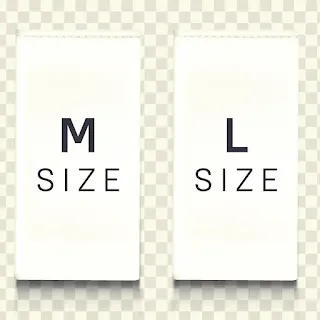Introduction
In the dynamic fashion world, where every thread makes a difference and every detail counts, the labels on garments are the hidden pieces of paper or cloth that hold the tale of all the clothes we wear. Whether it is the luxurious silk top that rests in our wardrobe or the common cotton t-shirt that is kept in our drawer, each item of clothing tells its tale through meticulously designed labels.
Garment labels have evolved well beyond simple brand identification. They have become sophisticated communication tools that bridge the gap between manufacturers and consumers, communicating a variety of information from care instructions to compliance certifications. In today's global fashion world, where the intersection of sustainability and style is taking place and transparency drives consumer choice, understanding garment labels is more important than ever.
1. Woven Labels
Woven labels are created through the use of custom looms that intricately weave both text and patterns directly into the fabric. These durable forms can withstand several washing cycles without losing their crisp look. They are frequently front-and-center on high-end garments, where quality and durability concerns are mostly at center stage. The complex weaving process allows for the use of complicated designs, multiple colors, and close attention to detail, making brands instantly recognizable.
 |
| Woven Label |
2. Printed Labels
Adaptable and cost-effective, printed labels use a variety of printing techniques to apply information to materials or synthetic materials. The labels are optimally applied to the display of complex care labels, size information, and colorful brand logos. Printing technology today has significantly changed these labels, offering everything from simple single-color prints to complex multicolor prints of photographic quality. Heat transfer printing, screen printing, and digital printing all offer individual advantages for particular applications.
 |
| Printed Label |
3. Heat Transfer Labels
Pioneers in convenience, heat transfer labels bond permanently with fabric fibers using heat and pressure. These labels do away with the itchy sensation common with sewn-in labels and are now very popular for use in intimate wear and children's garments. The seamless integration provides a smooth, comfortable wear while keeping all information in sight.
 |
| Heat Transfer Label |
Interlining Types, Properties and Machines
4. Leather Labels
The combination of luxury and functionality renders leather labels the favorite luxury fashion items. These sophisticated labels add a touch of artistry and exclusivity to garments. Usually featuring embossed branding details, leather labels are most typically seen on denim, leather, and high-end outerwear. The longevity and aging properties of these labels typically enhance the beauty of the garment with the passage of time.
 |
| Leather Label |
Items of a Jacket (outerwear) to Construct
5. Paper Labels
Though temporary representatives of fashion labels, paper labels serve important functions in retail settings. Hang tags composed of different types of paper convey pricing, details of seasonal collections, and promotional messages. Although designed to be discarded before use, the labels are converted into valuable objects by fashion consumers and convey essential information during the consumer decision process.
 |
| Paper Label |
Top 15 Fashion Designers in the World
6. Size Labels
Accuracy is paired with practicality in the context of size labels, which have become more sophisticated in the modern and diversified fashion market. Along with simple numeric or alphabetical sizing, modern size labels often include international size equivalents, body measurements, and fit guidelines. The labels adhere to local sizing standards while helping consumers make informed buying decisions across brands and geographical locations.
 |
| Size Label |
7. Care Labels
Far and away, the most significant mark from a garment durability perspective, care labels are printed in a universal language of symbols that are neither culturally nor linguistically specific. They advise consumers on proper washing, drying, ironing, and dry-cleaning procedures. As technical fabrics and fiber blends have proliferated, care labels have become more specific, often detailing temperature and fabric-specific care information.
 |
| Care Label |
8. Brand Labels
For industry representatives, these labels are synonymous with brand visibility and identity. From plain typographic representations to complex logos (metal-engraved), brand labels portray key brand values, history, and market positioning. They serve as quality assurance indicators and enable consumers to identify authentic products in markets saturated with counterfeits.
 |
| Brand Labels |
9. Composition Labels
Transparency pioneers in the modern conscious consumer economy, composition labels state exactly what materials make up each item. They list fiber percentages, allowing consumers to make informed decisions on comfort levels, care requirements, and environmental consciousness. With consumers increasingly concerned with sustainable fashion, composition labels introduce consumers to natural fibers, recycled content, and eco-friendly fabric innovations.
 |
| Composition Label |
Top 15 Indian Fashion Designers You Must Know
Effluent Treatment Plant in Textile Industry
10. Safety and Compliance Labels
Complied with by the regulatory bodies that oversee consumer interests, these labels meet several national and global safety standards. From warning labels for flame retardants to the revelation of chemical treatments, these labels ensure that the garment meets safety requirements. Garments meant for children often show additional safety details, while workwear includes relevant safety certifications and compliance marks.
 |
| Safety and Compliance Label |
Purpose of Garment Labels
Garment labels serve a number of critical functions far beyond simple identification. They are complex information systems that protect the interests of both the consumer and the manufacturer, as well as facilitate smooth commercial transactions.
1. Consumer Protection and Safety
This is the major objective of most garment labels. Care labeling prevents garment damage and increases the durability of clothes, and safety warnings save users from any possible danger. Composition labeling assists people with allergies or sensitivities in making safe selections of apparel, and size labeling provides proper fit and comfort.
2. Legal Compliance and Regulation
Some requirements vary by country and region, making correct labeling essential for worldwide trade. Labels are required to meet specific standards regarding disclosure of fiber composition, country of origin identification, and compliance with safety regulations. Failure to abide by these regulations can result in severe penalties and restrictions on market entry.
3. Brand Identity and Marketing
The application of labels makes it a more powerful marketing instrument. Consistent labeling design reinforces brand recognition and communicates brand values to the customer. Premium labels can add perceived product value, and open, professional labeling increases consumer confidence and trust.
4. Supply Chain Management
The industry relies heavily on label information for inventory tracking, quality control, and distribution efficiency. Labels assist in stock management by the retailers, aid loss prevention, and ease the returns process. Date codes for manufacturing and batch information enable effective quality control and recall procedures when needed.
5. Consumer Education and Empowerment
Full labeling enables deliberate buying decisions by consumers. Clear care instructions prolong garment life, composition details aid sustainable shopping decisions, and size guides lower return rates and increase customer satisfaction.
Importance of Garment Labels in Fashion Design
In the creative field of fashion design, labels do more than serve their basic purposes; they become vital elements of the broader design philosophy and brand narrative.
1. Integration of Design and Aesthetic Harmony
It involves thoughtful label positioning, size, and visual effect on the overall design of the garment. Good designers incorporate labels within their design framework, positioning them neatly within seam lines, selecting complementary colors, and letting them add to and not subtract from the aesthetic value of the garment. The label thus becomes part of the design narrative and adds to the overall visual and tactile experience.
2. Brand Storytelling Through Labels
It allows designers to express their vision and values through carefully crafted labels. Luxury brands invest significant resources in label creation, using high-quality materials and sophisticated manufacturing techniques to reinforce their market position. Sustainable brands employ ecologically friendly label materials and offer clear communication to maintain their devotion to environmental responsibility.
3. Consumer Experience Enhancement
Thoughtful label design improves the overall wear and care experience. Soft, smooth labels reduce irritation, and easy-to-read, easy-to-understand information simplifies garment care. Innovative label placement and attachment methods can erase significant comfort issues while maintaining important information availability.
4. Technology and Innovation Integration
Labeling is an extension of broader fashion industry trends towards intelligent textiles and internet-enabled apparel. QR code links to labels lead consumers to digital care labels, authenticity verification, and brand experiences. RFID tags enable inventory management and fraud prevention solutions with potential future connectivity advantages.
5. Cultural and Regional Adaptation
The label design recognizes the international character of fashion markets today. Labels now need to be presented in several languages, conform to regional sizing, and address cultural aesthetics, all while preserving brand consistency. Such a widespread challenge demands advanced design strategies that balance global brand identity with local market specificities.
6. Environmental Responsibility and Sustainability
Eco-friendly brands choose sustainable label materials, waste is minimized on labels, and labels are used to communicate environmental actions. Biodegradable labels, minimal packaging, and recycled content integrate label choices with overall sustainability goals.
Drawing Fashion Design Sketches for Beginners
Conclusion
The study of garment labels reveals a complex system that is distinguished by information sharing, regulatory policies, creativity, and the protection of consumer rights. These small but influential components of garments pose a big challenge, serving as the bridge for producers and consumers while promoting the interests of both.
Component of Basic and Denim Pant
As the fashion industry moves toward greater transparency, sustainability, and consumer awareness, garment labels will take on increasingly important roles. Garment labels will continue to adapt to new technologies, changing policies, and shifting consumer expectations, even as they maintain their basic roles of communication and protection.
Knowledge of garment labels enables consumers to make more informed decisions, take proper care of their garments, and buy from brands with which they share values. For fashion professionals, learning about the secrets of garment labeling presents possibilities for developing brand communications, complying with regulations, and designing positive experiences for consumers.
